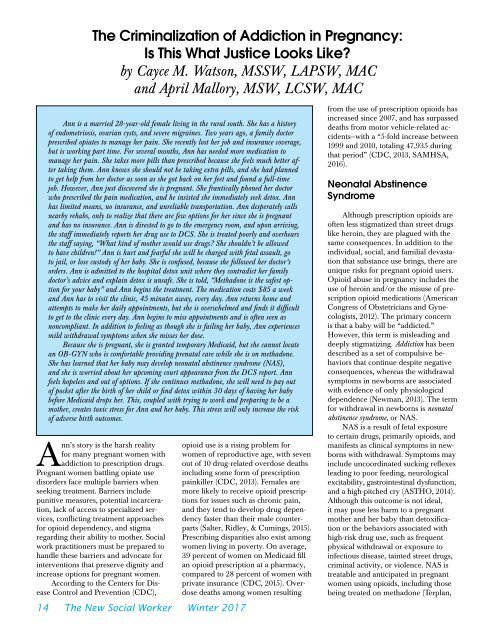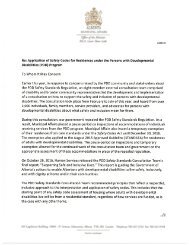In This Issue
click
click
You also want an ePaper? Increase the reach of your titles
YUMPU automatically turns print PDFs into web optimized ePapers that Google loves.
The Criminalization of Addiction in Pregnancy:<br />
Is <strong>This</strong> What Justice Looks Like?<br />
by Cayce M. Watson, MSSW, LAPSW, MAC<br />
and April Mallory, MSW, LCSW, MAC<br />
Ann is a married 28-year-old female living in the rural south. She has a history<br />
of endometriosis, ovarian cysts, and severe migraines. Two years ago, a family doctor<br />
prescribed opiates to manage her pain. She recently lost her job and insurance coverage,<br />
but is working part time. For several months, Ann has needed more medication to<br />
manage her pain. She takes more pills than prescribed because she feels much better after<br />
taking them. Ann knows she should not be taking extra pills, and she had planned<br />
to get help from her doctor as soon as she got back on her feet and found a full-time<br />
job. However, Ann just discovered she is pregnant. She frantically phoned her doctor<br />
who prescribed the pain medication, and he insisted she immediately seek detox. Ann<br />
has limited means, no insurance, and unreliable transportation. Ann desperately calls<br />
nearby rehabs, only to realize that there are few options for her since she is pregnant<br />
and has no insurance. Ann is directed to go to the emergency room, and upon arriving,<br />
the staff immediately reports her drug use to DCS. She is treated poorly and overhears<br />
the staff saying, “What kind of mother would use drugs? She shouldn’t be allowed<br />
to have children!” Ann is hurt and fearful she will be charged with fetal assault, go<br />
to jail, or lose custody of her baby. She is confused, because she followed her doctor’s<br />
orders. Ann is admitted to the hospital detox unit where they contradict her family<br />
doctor’s advice and explain detox is unsafe. She is told, “Methadone is the safest option<br />
for your baby” and Ann begins the treatment. The medication costs $85 a week<br />
and Ann has to visit the clinic, 45 minutes away, every day. Ann returns home and<br />
attempts to make her daily appointments, but she is overwhelmed and finds it difficult<br />
to get to the clinic every day. Ann begins to miss appointments and is often seen as<br />
noncompliant. <strong>In</strong> addition to feeling as though she is failing her baby, Ann experiences<br />
mild withdrawal symptoms when she misses her dose.<br />
Because she is pregnant, she is granted temporary Medicaid, but she cannot locate<br />
an OB-GYN who is comfortable providing prenatal care while she is on methadone.<br />
She has learned that her baby may develop neonatal abstinence syndrome (NAS),<br />
and she is worried about her upcoming court appearance from the DCS report. Ann<br />
feels hopeless and out of options. If she continues methadone, she will need to pay out<br />
of pocket after the birth of her child or find detox within 30 days of having her baby<br />
before Medicaid drops her. <strong>This</strong>, coupled with trying to work and preparing to be a<br />
mother, creates toxic stress for Ann and her baby. <strong>This</strong> stress will only increase the risk<br />
of adverse birth outcomes.<br />
Ann’s story is the harsh reality<br />
for many pregnant women with<br />
addiction to prescription drugs.<br />
Pregnant women battling opiate use<br />
disorders face multiple barriers when<br />
seeking treatment. Barriers include<br />
punitive measures, potential incarceration,<br />
lack of access to specialized services,<br />
conflicting treatment approaches<br />
for opioid dependency, and stigma<br />
regarding their ability to mother. Social<br />
work practitioners must be prepared to<br />
handle these barriers and advocate for<br />
interventions that preserve dignity and<br />
increase options for pregnant women.<br />
According to the Centers for Disease<br />
Control and Prevention (CDC),<br />
opioid use is a rising problem for<br />
women of reproductive age, with seven<br />
out of 10 drug-related overdose deaths<br />
including some form of prescription<br />
painkiller (CDC, 2013). Females are<br />
more likely to receive opioid prescriptions<br />
for issues such as chronic pain,<br />
and they tend to develop drug dependency<br />
faster than their male counterparts<br />
(Salter, Ridley, & Cumings, 2015).<br />
Prescribing disparities also exist among<br />
women living in poverty. On average,<br />
39 percent of women on Medicaid fill<br />
an opioid prescription at a pharmacy,<br />
compared to 28 percent of women with<br />
private insurance (CDC, 2015). Overdose<br />
deaths among women resulting<br />
14 The New Social Worker Winter 2017<br />
from the use of prescription opioids has<br />
increased since 2007, and has surpassed<br />
deaths from motor vehicle-related accidents—with<br />
a “5-fold increase between<br />
1999 and 2010, totaling 47,935 during<br />
that period” (CDC, 2013, SAMHSA,<br />
2016).<br />
Neonatal Abstinence<br />
Syndrome<br />
Although prescription opioids are<br />
often less stigmatized than street drugs<br />
like heroin, they are plagued with the<br />
same consequences. <strong>In</strong> addition to the<br />
individual, social, and familial devastation<br />
that substance use brings, there are<br />
unique risks for pregnant opioid users.<br />
Opioid abuse in pregnancy includes the<br />
use of heroin and/or the misuse of prescription<br />
opioid medications (American<br />
Congress of Obstetricians and Gynecologists,<br />
2012). The primary concern<br />
is that a baby will be “addicted.”<br />
However, this term is misleading and<br />
deeply stigmatizing. Addiction has been<br />
described as a set of compulsive behaviors<br />
that continue despite negative<br />
consequences, whereas the withdrawal<br />
symptoms in newborns are associated<br />
with evidence of only physiological<br />
dependence (Newman, 2013). The term<br />
for withdrawal in newborns is neonatal<br />
abstinence syndrome, or NAS.<br />
NAS is a result of fetal exposure<br />
to certain drugs, primarily opioids, and<br />
manifests as clinical symptoms in newborns<br />
with withdrawal. Symptoms may<br />
include uncoordinated sucking reflexes<br />
leading to poor feeding, neurological<br />
excitability, gastrointestinal dysfunction,<br />
and a high-pitched cry (ASTHO, 2014).<br />
Although this outcome is not ideal,<br />
it may pose less harm to a pregnant<br />
mother and her baby than detoxification<br />
or the behaviors associated with<br />
high-risk drug use, such as frequent<br />
physical withdrawal or exposure to<br />
infectious disease, tainted street drugs,<br />
criminal activity, or violence. NAS is<br />
treatable and anticipated in pregnant<br />
women using opioids, including those<br />
being treated on methadone (Terplan,




